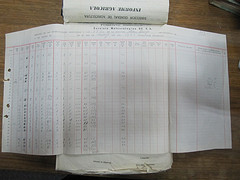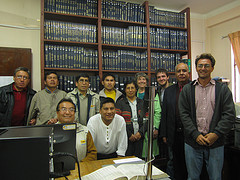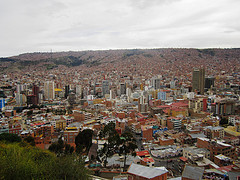 Data at Risk: Much of the historical weather data at the Bolivian National Meteorological Service (SENAMHI) is at risk of being lost forever. The data is diverse and includes agricultural information such as soil temperature at various depths.
Data at Risk: Much of the historical weather data at the Bolivian National Meteorological Service (SENAMHI) is at risk of being lost forever. The data is diverse and includes agricultural information such as soil temperature at various depths.
The data is organized in books but there is no catalog of the bounded data. In addition to the bound data, there are also rolls of precipitation strip charts that are saved in boxes both on site and at off site locations.
In addition to this critical data being recorded on rapidly deteriorating paper, it is virtually impossible to use the data for any useful purpose in it’s current state. The lack of inventory makes it challenging to determine exactly how much information is currently available. What we do know is that there are hundreds upon hundreds of volumes on site, each containing hundreds of pages, and within those pages, hundreds of weather parameter values such as temperature, wind, pressure, rainfall and more. In the archive’s current state, it is impossible to retrieve any useful information. For example, to find the highest temperature recorded in Bolivia using these records, it would take an investigator well over a year to search through all the volumes. However, once all the data in those volumes are photographed, digitized and available in an electronic data base, an investigator would find the answer in a matter of seconds.
 Initiating the Rescue of Bolivia’s Climate Data: Dr. Sharon LeDuc, IEDRO’s Chief Scientist, visited SENAMHI in Februray of 2011 to discuss roles and responsibilities between IEDRO and SENAMHI for data rescue efforts.
Initiating the Rescue of Bolivia’s Climate Data: Dr. Sharon LeDuc, IEDRO’s Chief Scientist, visited SENAMHI in Februray of 2011 to discuss roles and responsibilities between IEDRO and SENAMHI for data rescue efforts.
The objective was to outline the data rescue mission: to support data rescue and digitization in Bolivia according to a two-phase project plan, as well as to coordinate management and implement the project’s technical and administrative aspects. A presentation was made, and a camera was given to SENAMHI with the focus on proposed cooperation on the project.
Data Rescue Process: In April of 2012, Dr. LeDuc led a second IEDRO data rescue team to LaPaz, Bolivia to initiate IEDRO’s 15th data rescue and digitization project. Darío Damián Di Franco, IEDRO’s South American Program Manager and Teddy Allen, IEDRO’s Manager of Scientific Applications, a Ph.D. candidate at the University of Miami, accompanied her on this trip.
A computer system were purchased and installed along with a stand to mount the camera for digitizing books, allowing the training of three SENAMHI employees in the process of imaging, documenting and transferring rescued data. Photographs of samples of data were collected that required imaging and Teddy Allen performed a demonstration and training session of how to easily make lifesaving analyses.
To begin the project, the initial imaging emphasis was was placed on imaging non-strip chart data from Bolivia’s historic data library.
In July 2012, the next activities were built on the introductory stage, focused on ensuring an efficient and continuous flow of data from SENAMHI to IEDRO. IEDRO installed free online online software to assist in the delivery. Future activities planned are to include imaging SENAMHI’s other types of data.
If funding is secured, IEDRO plans to visit SENAMHI, the Bolivian meteorological agency, in 2016 to ensure that the rescue of surface observations continues. IEDRO will also coordinate with Rotary International and the Bolivian Rotary to assist in the digitization of the SENAMHI data through Weather Wizards.
 Goals: Once digitized, the digital dataset will be provided for incorporation into the database at NCDC. Users from across the world will be able to access this information at no charge. This data will be of tremendous value to scientists who research various phenomenon including global climate change, hind cast studies, climate model evaluation, and statistical climate analysis. Applications of this work include, but are not limited to agricultural, hydrologic, energy, and economic policies.
Goals: Once digitized, the digital dataset will be provided for incorporation into the database at NCDC. Users from across the world will be able to access this information at no charge. This data will be of tremendous value to scientists who research various phenomenon including global climate change, hind cast studies, climate model evaluation, and statistical climate analysis. Applications of this work include, but are not limited to agricultural, hydrologic, energy, and economic policies.
Progress: Between July 2012 and September 2013, IEDRO personnel began receiving surface data images from Bolivia. To date, IEDRO has received synoptic observations and Summary of Day observations for 22 surface stations – 16,544 pages/records in total, the equivalent of at least 10 years of data.
Status/2015 Update: In anticipation of the completion of the production version of Weather Wizards in 2016, IEDRO formulated an initial plan for digitizing the data images already received from Bolivia. Bolivia has many strip charts that also need to be digitized. IEDRO is currently awaiting additional images and funding for further data rescue efforts to be completed.
Funding needs: Funding is required to develop digital keying formats for the dozens of different types of meteorological forms rescued from Bolivia so that IEDRO’s Weather Wizards system can be used to digitize the data. $15,000 in funding is needed to complete the project.
